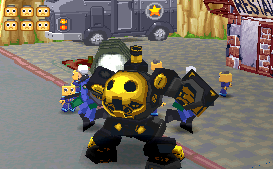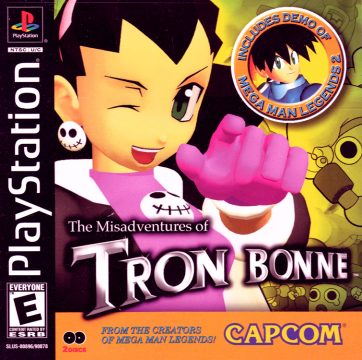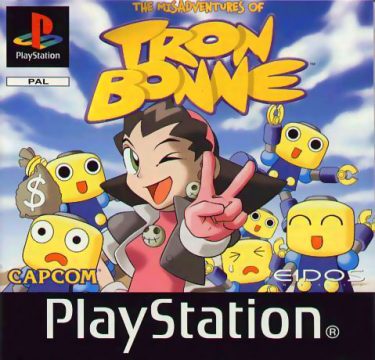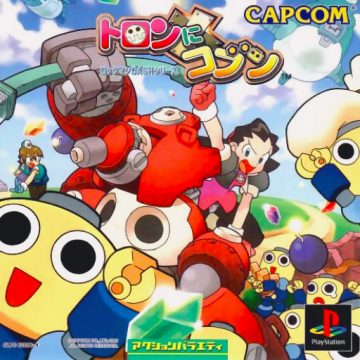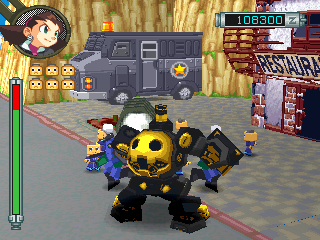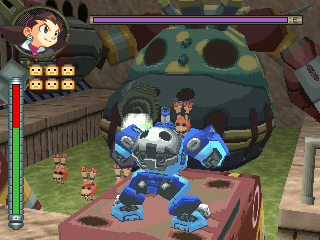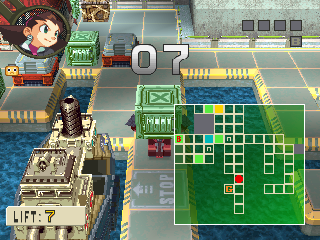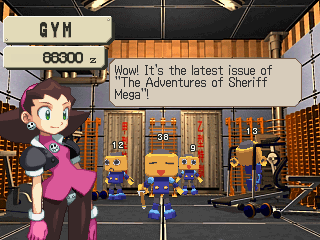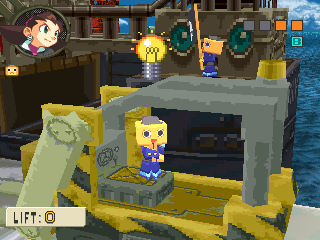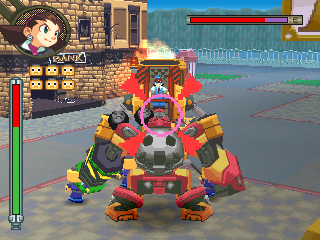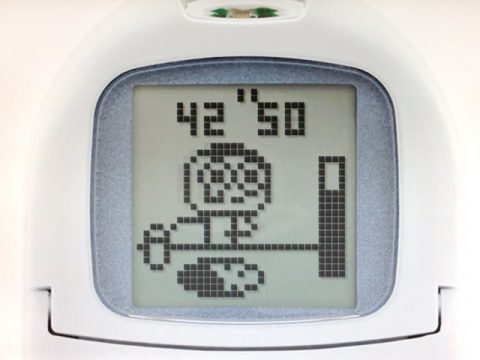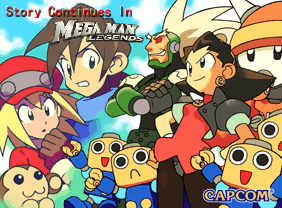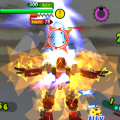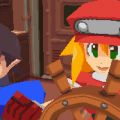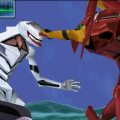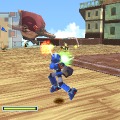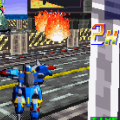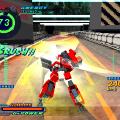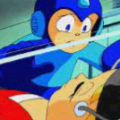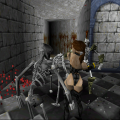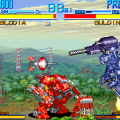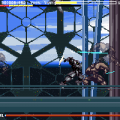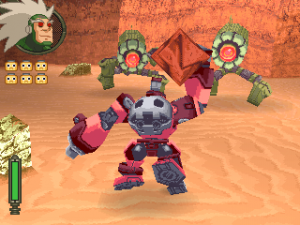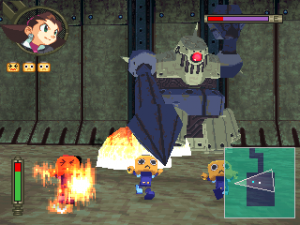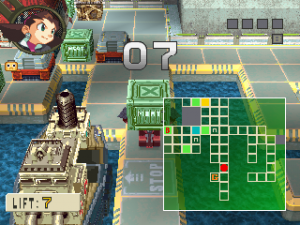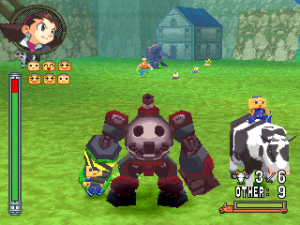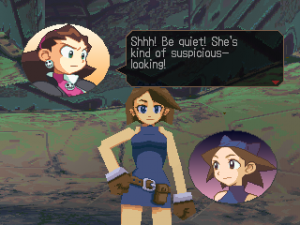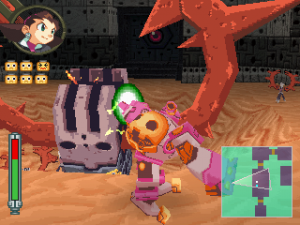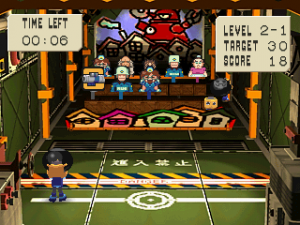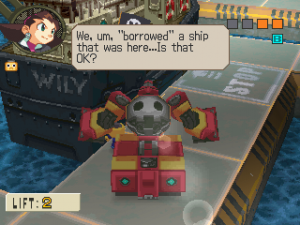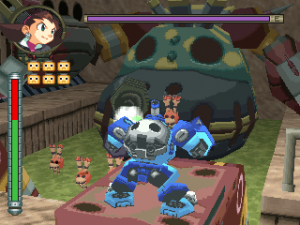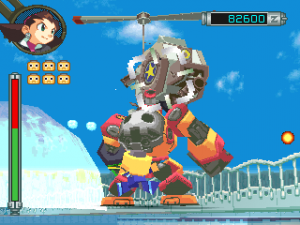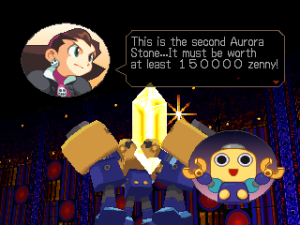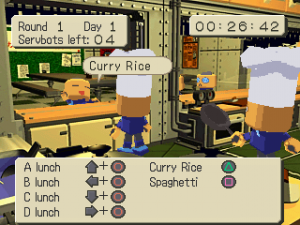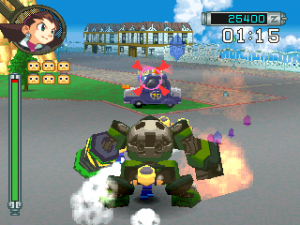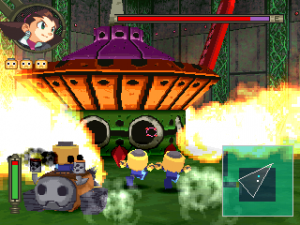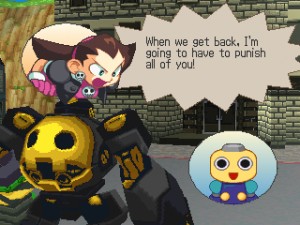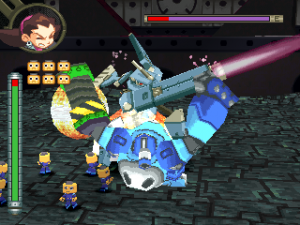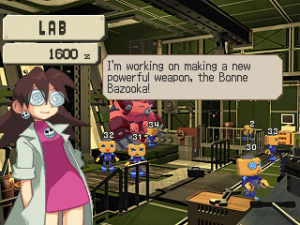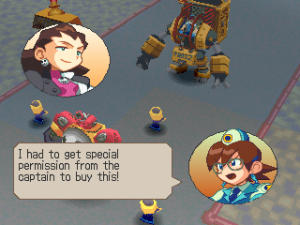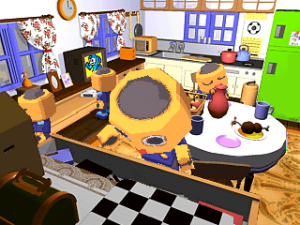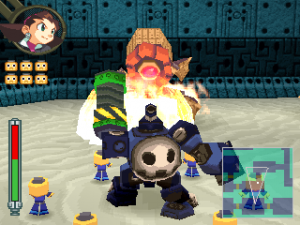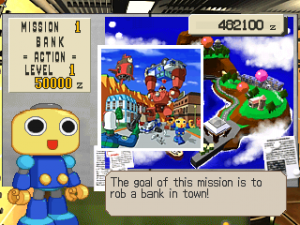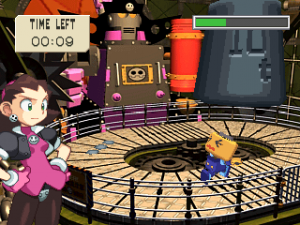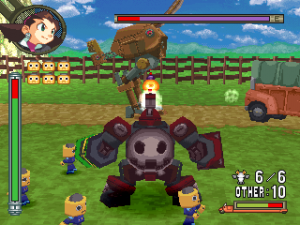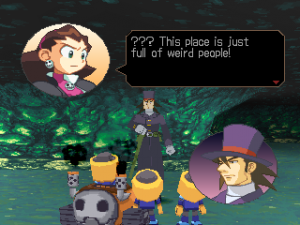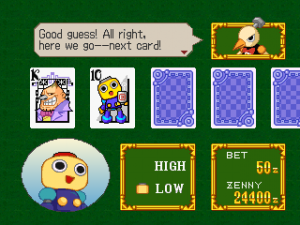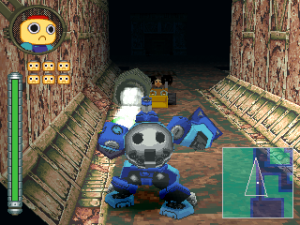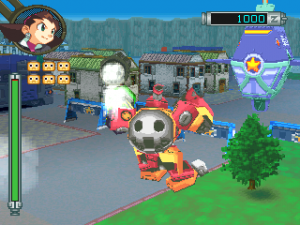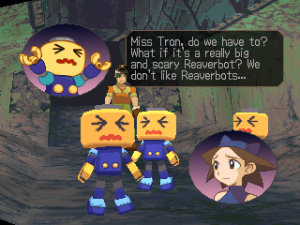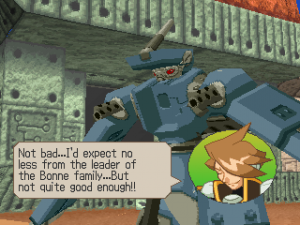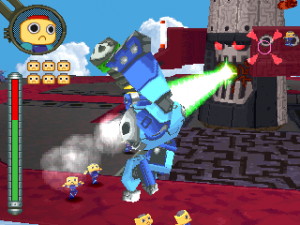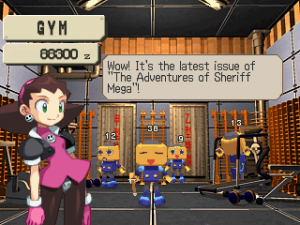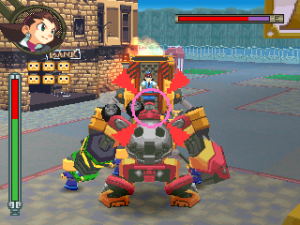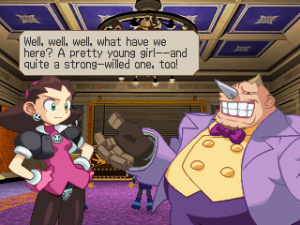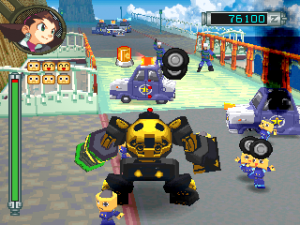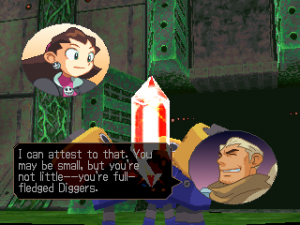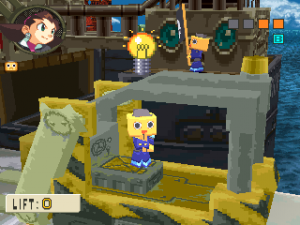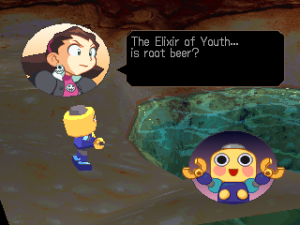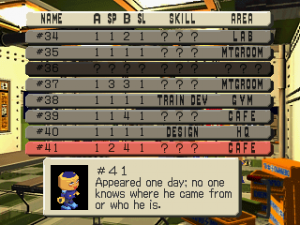- Mega Man Legends
- Misadventures of Tron Bonne, The
- Mega Man Legends 2
With Tron and the Servbots becoming the dark horse fan faves from the first game, the devs at Capcom’s Studio 2 created a gaiden game with focus on them along with laying out the beginning of the sequel. Without a Mega Man in sight outside of tiny cameos, The Misadventures of Tron Bonne serves as a prequel to the events on Kattlelox Island to bring light of shenanigans and troubles the Bonne family were up to before a certain blue boy and his crew entered their lives. As a hodgepodge of gameplay styles rolled into a narrative, this spin-off only partially feels like the mainstream Legends titles and more resembles a sky pirate sim.
From the start, Teisel is piloting the (usually) bipedal mech suit Gustaff out near the ruins in the Nakkai Desert in search of a profitable find. His brief stint at the helm is solely a tutorial as he isn’t used to the controls of his sister-built mecha and has to have her serve as his Spotter. The brash elder son hopes to dig up the elusive Refractor treasure within the ruins, the Diana’s Tear, in order to pay back the loan he got for constructing the Gesellschaft. It’s too bad for the Teisel that he got the loan from Lex Loath, as his business’ raison d’être is to trap Diggers of merit like the Bonnes to be shanghaied into slave work. It isn’t long until both Bonne brothers are detained by Glyde coming to collect what Loath is due.
That is where Tron comes in. The overarching goal of the game is to rescue her kidnapped siblings by finding means to collect enough funds to pay their debt. Being a pirate by trade, many of the methods available are criminal, but just as lucrative, in nature. Using the Gustaff, Tron can rob banks, steal cargo, fleece farm animals, or go digging for Refractors. While not on these Zenny-grabbing runs, Tron can bounce around various rooms within the Gesellschaft to chat with/train/order/punish her Servbots, upgrade her arsenal, and buy/sell materials. While these sections in the ship are exclusively menu-based, it provides downtime between missions and means to boost your efforts for everything from finding a Servbot’s hidden talent to discovering a new paint job for your Gustaff. Each new room and amount of minions to interact with expands over time as you return with more Zenny on hand, but the most important ones you’ll visit constantly are available at default: HQ for saving and starting missions, the Lab for R&D, and the Gym for Servbot training.
The missions are divided into 6 areas with 3 distinct gameplay types. The majority of these center around a 3rd person view of Tron piloting the Gustaff with six Servbots to fundamentally order around to plunder or assist in butt-kicking. This includes the bookending Teisel starting mission and the final level, along with the main Missions 1 & 5 (Gold City’s bank robberies and Sart Farm’s livestock heist, respectively) as well as the “endless” Nakkai Ruins 4th mission to find the Diana’s Tear. Mission 3 is dubbed the “RPG” set of challenges within the Shala-Kun Ruins’s rock tunnels in a first-person viewpoint like an old-fashioned dungeon crawl. Tron mans the floating camera bot Finkel in these missions to guide a trio of Servbots as they bore deeper underground. Rounding out the last two set of missions are puzzle-based crate-moving maps on docks in two harbors. Mission 2 at Teche Harbor has Tron doing the heavy-lifting solo, but the later brain-taxing Mission 6 at Primiki Harbor adds the task of guiding a forklift-driving/crane-operating Servbot into the fold. Thus, the routine becomes this: send three Servbots out into the island to scout about for items (optional, but the bots tend to find something of value), select a mission, choose a co-pilot and minions suited for the task, and arrive back home fruitful and successful with booty in tow. Between these areas and the added locations on the map to send Servbots to, Ryship Island is a more motley vista to trek than Kattelox’s overground segments.
The action portions feel right at home with the standard Legends in terms of play. Tron’s Gustaff stomps and attacks not unlike Mega Man Volnutt with almost the exact same tank controls. The major change is the lock-on button has been moved to L2 so R2 can send out a Beacon Bomb to guide Servbots. Moreover, Misadventures includes Auto-Aim as an option. Being larger in size to our blue hero, the camera is panned out farther back and higher to compensate so as to not make it an issue with blocking threats in front of you — most of the time. At its form, the Gustaff lumbers as a stockier Volnutt with most threats either larger than you or aerial in nature, so rarely is there a tiny annoyance bombarding Tron right in front of her nose where the player can’t see. While the mech can be outfitted with three different offensive cannons, throwing a beacon onto an enemy launches orders for Tron’s 6 Servbots to attack or at least slow a targeted foe down. These beacons are also required to send the minions into houses and cracks in walls where the Gustaff can’t fit, and the adorable bots will gladly ransack and cheerfully bring back any spoils they nabbed. The Servbot’s AI will pick up any refractor or mission-specific livestock to bring to Tron or a collection vehicle, but those brought out on the field lacking sufficient level of brainpower will need to be Beacon’d towards loot until they catch on. For the most part, a lot of the missions are an expansion of Legend’s gameplay with added management detail.
Management is crucial in the harbor missions. Tron’s Gustaff is put in its tank form and can only lift crates or objects a handful of times and is only able to haul precious stolen items a set amount of blocks on the grid of the levels. While not quite Sokoban, the brain teasing evolves in the later stages as Tron has to move blocking crates, work conveyor belts, and make bridges in the sea for shortcuts while being tempted with bonus luxury crates to steal. Only one sole Servbot tags along, able to be ordered to fish for, well, fish or other sunken goodies, or raid the shipyard’s guard’s lunch. The Servbot can also give hints, but they’ll only be good if its smarts are at a high level. Of course, the second set of missions change it up enough that Tron’s job is merely to clear paths so her selected robo buddy can do the heavy-lifting of the cargo with the available machinery. These later set of puzzles can be overly long to solve, not helped with the Servbot having to crunch the pathfinding after being Beacon’d to a crate. To alleviate hair-pulling frustration, the menu has a do-over button to reset to the beginning of each box puzzle in case of any mistake.
Breaking from the head-scratching and direct action stages is the unique Finkel-piloted cave missions. Being a fragile remote drone, it is necessary to set beacons to let your nigh-indestructible minions hop into the fray to disarm traps, grab treasure, and deal with Reaverbots, not to mention talk to the other Diggers you run across. In a slice of world-building, players get to experience an excavated ruin filled with other folks vying for their share of a claim, either handing out friendly advice, or looking out for no.1. It is a shame that most of these portions feel drab and drawn-out, making the tunnel searching a slog with samey brown stone walls and tedious battles. The remote controlled Finkel isn’t built for offense, with only a ramming strike that takes a toll on its HP and a goofy horn to catch Diggers’ attention. Thus most Reaverbot run-ins and ambushes involve sitting in the corner and sending your Servbots in to slowly wear the many-times explosive baddies to scrap. Add to the fact that the chattiness of the RPG segments borders on the grating. Each type of mission through the misadventures does have its share of tutorial explanations given via dialogue and text briefings, but the first-person tunnel-spelunking takes it to levels only reached in modern gaming hand-holding conventions. The first time in Shala-Kun is especially egregious with the action stopping with each Digger met or observation made by the Servbots. Everything from disarming a trap with a blatantly observable switch nearby to even required talking to someone to bypass a door is doled out with exposition and explanation in an alarming rate. Even later into the ruins, the Servbots will constantly stop to excitingly announce to Tron and the player their routine actions over and over with child-like enthusiasm, whether it’s the 1st or 20th time performing the same task: “Look Miss Tron, we found some money!” “Look, we found a Key!” “Miss Tron, we found a Treasure Chest! May we used the Key we found to open it?”
Stashed away later in Misadventures‘s playthrough is a bonus minigame, available only after selecting a fave Servbot and donning it the coveted Red Head Part (important to designate the leading Servbot in the final mission). With a favorite chosen, Tron can choose to rest in her bed, leaving the Red-Capped minion to sneak out and try to help earn cash in Casino Town Nukky. Despite the establishment being run by Birdbots, they gladly let you in to bet on either a game of Bingo or High and Low. As rewarding as it can be with lady luck on your side, ultimately it’s wiser and safer to farm Reaverbots or miscellaneous loot for cash.
While strengthening the Gustaff is vital for majority of the missions, the Servbots need to level up as well to get the most out of them. Each Servbot is numbered, ranked via stats of four, and have their individual skills and personalities. They can even be nicknamed, if you choose. Attack is self-explanatory. Speed governs the swiftness of a Servbot as well as its dexterity, with high Speed bots less likely to trip up on the job. Brain measures how on the ball the minion is on the field, and allows certain Servbots to offer better tips. Sloth itself does nothing, but any Servbot that reaches Level 4 by not given work will slack off until punished. Some of the special skills of a Servbot won’t be discovered unless they go on missions or are handed the right item. Many of these skills are offensive-based and are the better choices on fight-based quests. After all, against cops, it’s better to bring a Servbot that can handle a bazooka than one that’s good at poetry.
One of the major issues within Misadventures is the tedious nature of training Servbots. Their Brain and Sloth stats are governed by their time out on missions, the former gained mostly by being ordered to search in buildings and holes in the wall while the latter by being active on duty. However, Attack and Speed can only be boosted in the Gym, which requires performing three minigame rounds in a row in order to go up one level. Coupling this with certain Servbots’ capabilities in each stat reaching four levels and there being 40 bots in all, it is best to focus on only the half-dozen you wish to use throughout the game. There are ability cubes that instantly gain a Servbot’s stat by one, but they are rare outside of the Energy Cubes to curtail Sloth, and are better reserved for the player’s key team for their Level 4 boost as the minigames for both Attack and Speed at that level are maddeningly difficult to complete within the time limits given. Equally frustratingly challenging is whipping a lazy Servbot into shape in the Torture Room — fittingly only unlocks once one bot starts loafing about at Lvl 4 Sloth. This minigame uses three traps to humorously cause injury to the goof-off bot, but his attitude won’t be swayed unless he receives adequate punishment. Given the brief period allotted to administer said punishment, if the Servbot evades the traps more than twice, there won’t be enough time to cure its lethargy. The insolent robot runs faster with each bit of pain given, so the final blows needed require precision timing along with the clock counting down.
The greatest flaw, however, in Tron Bonne’s misadventures is the replay value. Once a mission is completed, it can’t be replayed for the rest of the playthrough. Once all of the major mission are finished, the only options left are stomping through a cleared out Nakkai Ruins, playing in the casino, or tackling the final stage. This can lead to disappointment as once you run out of one type of play style or mission you prefer, you’re stuck with the only the remainder to complete the game. Missions 5 and 6 themselves don’t become available until you collect one million Zenny first, leaving those as some of your final means to acquire the second million needed for the last mission to unlock. Plus, since the missions are heavily linear with heavy copy-paste design, there’s no variety to expect in the battles and little options for mix-ups or experimentation. Should luck waver horribly, the player would be left trudging through the same one-map-only Nakkai Ruins to scrounge the remaining dosh needed (though not necessarily required, the Diana’s Tear awaiting at the end of the ruins protected by a puzzle boss nets an appraised one million Zenny by itself). For some players, this gaiden game might be more of a one-and-done.
That isn’t to say Misadventures isn’t without charm, but more hit-or-miss. The title really shines when Tron is being at her baddest and her minions at their most incompetent. The highlight missions are the bank heists, pitting Tron against newbie police officer Denise and the bad sense of direction from her Servbots. In fact, the Servbots steal the show as many of the gleefully moments within the game are caused by them. As woefully underdog as Denise’s plight becomes, the minions are along for the ride for the entire run, their doe-eyed expressions grimacing into anger, sadness, fear, and anguish all throughout. One look of the robots happily carrying a pig, wearing a chef’s hat, being squished flat Wily E. Coyote style, or running covered in fire is enough to show how much power they had as mascots. Considering that many of the minigames and segments are devoted to the Servbots with Tron not around showcases how focused the dev team was spotlighting the real stars, overshadowing the anti-heroine at multiple points and making her more reactionary to their antics and inquiries. It becomes so central that the level of chattiness the Servbots have walks a tight rope. Have them interact too little (The harbor missions) and the game feels more boring, but have them interact too much (Shala-Kun Ruins) and it grows grating. For those sweet spots of the play-by-play with the Servbots, Tron, and the rest of the cast that the game shines. Even the laughable ending where the Bonnes are left back at square one is caused by a Servbot’s snafu.
Tron Bonne, like Legends before it, was also dealt the censor hammer, though it’s impact was milder. In the Shala-Kun Ruins, there is a sidequest of searching for the “Elixir of Youth”, only to find out it was root beer hidden in an underground spring. The Japanese version originally called it the “Secret to Longevity”, and turned out to be saké. The Servbot that drinks the elixir still blushes and hiccups as if it was actually caused from intoxication (though how a robot gets tipsy is another matter). In addition, the innocent #40’s hidden talent wasn’t “Design”, but “Perversion”, as the magazine about interior design you can hand him was, in actually, an adult mag. His antics of sniffing Tron’s bed and bouncing on it remained in the game, regardless. The ending is mildly different in Japan, playing the pop song “love letter” by Mayumi Iizuka over the credits, along with showcasing three pieces of fan art and designs from selected winners of a contest. The International releases of Tron Bonne also remove compatibility with Sony’s Pocketstation, along with two in-game items related to unlocking minigames on the peripheral. These 2~4 games on the Pocketstation allow the player to upgrade up to three selected Servbot’s stats on the go outside of the Gym, from eating spicy curry to singing to running from a dog to finally aiming a cannon to the correct floor of a tall building. Leftover scripts and translated text for these menus are still in the game data, but are left broken when activated via a cheat device. Finally, one odd choice in the English versions was to redub Bon Bonne’s dialogue, which is still simply, “Babuu~” a handful of times.
Also hidden but not normally available is the 41st Servbot. Via a promotion through Dengeki G magazine, a save data rewrite adds in a peculiar blue-capped minion that hangs around in the cafeteria. This odd funny-faced Servbot cannot be chosen as Tron’s fave, but has the potential for max stats from the get-go. His data and text is fully implemented in the English version, but only accessed with a Gameshark code. #41 wasn’t the only weird faced bot, as unused anime-parodying Servbot face textures are still filed deep in the ROM, showing expressions based on Kinnikuman, a serious Fist of the North Star Kenshiro type, and Odate-Buta from Yatterman. Other beta elements lay dormant in the code or were changed/removed during beta stages. A bathroom and laundry room in the Gesellschaft were planned but ultimately scrapped, as well as a handful of unused skills for the Servbots like “Lookout” and “Steering”. Promo videos showed lazier inattentive Servbots thinking about curry while on the battlefield. Speaking of food, various unused cuisine items, possibly stolen on raids, were never implemented. Along with tools and parts to upgrade the Gustaff, Tron or her Servbots might have also found scattered memorabilia from her family, such as photos, Teisel’s business suit, and even Tron’s diary and pair of her underwear.
While stretching out the world and throwing in change ups to the Legends franchise, Misadventures ultimately feels more of a love-it-or-hate-it side story for those itching for more Tron and Servbot action. Its fleshing out and development of its star along with its heights can be overshadowed by the dredges and chores it can dish out. While it sold well in Japan, its low numbers created a small supply in North America, causing its price at auctions or secondhand shops to rocket into the triple digits. Luckily, after some fan push, the game saw a digital release on PSN worldwide, available even before any of the main titles in the US hit the service. The digital copy’s low price is far more palatable, even if the second disc isn’t available. Speaking of, the Japanese version’s bonus disc is a lot more substantial now than the North American’s variant, enough to be considered it’s own side quest.
